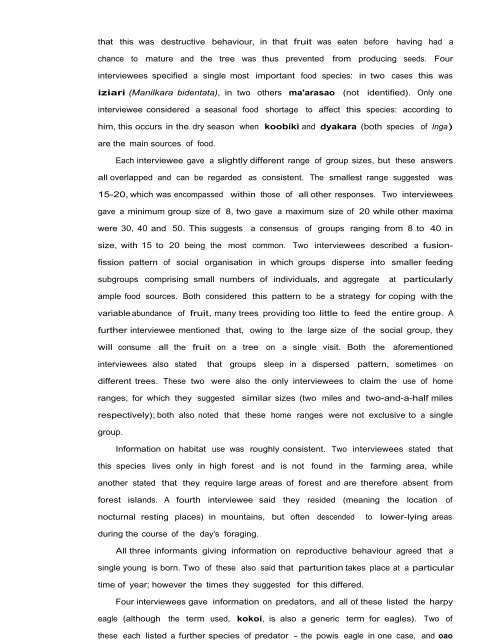Ethnoecology, Resource Use, Conservation And Development In A ...
Ethnoecology, Resource Use, Conservation And Development In A ...
Ethnoecology, Resource Use, Conservation And Development In A ...
You also want an ePaper? Increase the reach of your titles
YUMPU automatically turns print PDFs into web optimized ePapers that Google loves.
that this was destructive behaviour, in that fruit was eaten before having had a<br />
chance to mature and the tree was thus prevented from producing seeds. Four<br />
interviewees specified a single most important food species: in two cases this was<br />
iziari (Manilkara bidentata), in two others ma'arasao (not identified). Only one<br />
interviewee considered a seasonal food shortage to affect this species: according to<br />
him, this occurs in the dry season when koobiki and dyakara (both species of <strong>In</strong>ga)<br />
are the main sources of food.<br />
Each interviewee gave a slightly different range of group sizes, but these answers<br />
all overlapped and can be regarded as consistent. The smallest range suggested was<br />
15-20, which was encompassed within those of all other responses. Two interviewees<br />
gave a minimum group size of 8, two gave a maximum size of 20 while other maxima<br />
were 30, 40 and 50. This suggests a consensus of groups ranging from 8 to 40 in<br />
size, with 15 to 20 being the most common. Two interviewees described a fusion-<br />
fission pattern of social organisation in which groups disperse into smaller feeding<br />
subgroups comprising small numbers of individuals, and aggregate at particularly<br />
ample food sources. Both considered this pattern to be a strategy for coping with the<br />
variable abundance of fruit, many trees providing too little to feed the entire group. A<br />
further interviewee mentioned that, owing to the large size of the social group, they<br />
will consume all the fruit on a tree on a single visit. Both the aforementioned<br />
interviewees also stated that groups sleep in a dispersed pattern, sometimes on<br />
different trees. These two were also the only interviewees to claim the use of home<br />
ranges, for which they suggested similar sizes (two miles and two-and-a-half miles<br />
respectively); both also noted that these home ranges were not exclusive to a single<br />
group.<br />
<strong>In</strong>formation on habitat use was roughly consistent. Two interviewees stated that<br />
this species lives only in high forest and is not found in the farming area, while<br />
another stated that they require large areas of forest and are therefore absent from<br />
forest islands. A fourth interviewee said they resided (meaning the location of<br />
nocturnal resting places) in mountains, but often descended to lower-lying areas<br />
during the course of the day's foraging.<br />
All three informants giving information on reproductive behaviour agreed that a<br />
single young is born. Two of these also said that parturition takes place at a particular<br />
time of year; however the times they suggested for this differed.<br />
Four interviewees gave information on predators, and all of these listed the harpy<br />
eagle (although the term used, kokoi, is also a generic term for eagles). Two of<br />
these each listed a further species of predator - the powis eagle in one case, and oao


